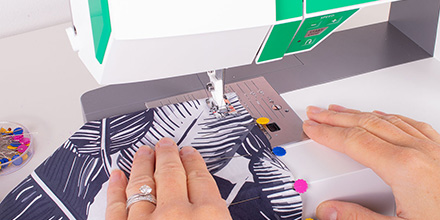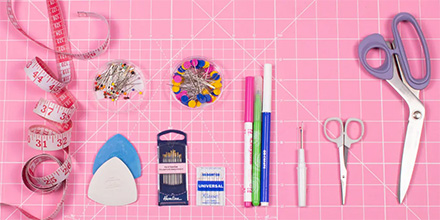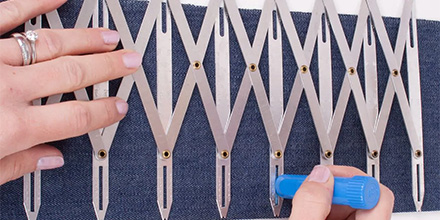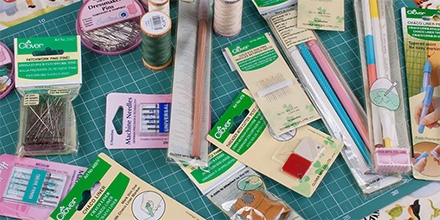Sewing Tools
Sewing tools are the foundation of every successful project. Measuring tapes, seam guides and marker pens or pencils help you accurately prepare your fabric and pattern pieces for cutting and sewing. Complete your preparation with sharp scissors or a rotary cutter and use pins or handy clips to hold everything securely in place. And for when those accidents inevitably do happen a good seam ripper is your best friend! With the right tools and careful setup, you’re all set for success, which means you can focus on enjoying the best bit: the sewing itself!
How Do I Choose the Right Sewing Tools?
Choosing the right sewing tools depends on your needs - whether you’re just starting out and want budget-friendly essentials, you’re a passionate sewist ready to invest in premium brands that will last a lifetime, or you’re searching for something a little more specialist and niche. At Sew Essential, we’ve curated a wide range of tools to suit every sewist, from beginners to seasoned makers.


We know our sewing tools
Not sure what belongs in your sewing toolkit? You’ll find helpful guides and articles further down the page to point you in the right direction and ensure you only buy what you really need to get started. And because our team are passionate sewists ourselves, we’ve tried and tested many of these tools in our own projects, so we can give you honest, practical advice you can trust.


Overcome even the trickiest of tasks
Once you’ve got the right sewing tools in your kit you can approach every sewing project free to focus on developing your sewing skills and experience. If you do run into any tricky challenges there’s no better feeling than ‘oooh I’ve got a tool for that!’


Sewing Tools FAQ
► What are the essential sewing tools for beginners?
Like everything these days there are literally millions of sewing tools on the market, which can feel incredibly overwhelming, especially for a beginner sewist. The key is to start with the basics, practice your sewing and later down the line you can add to your toolkit if you learn to really love your new hobby.
For all types of sewing the following tools are a compact list of essentials: a tape measure for measuring distances when laying out pattern pieces or marking specific points on fabric, scissors for cutting fabric and threads, pins to hold your fabric layers together ready for sewing, marking tools to mark out things like darts and pleats, hand sewing needles and a seam ripper to unpick stitches when things go awry (don’t worry it happens to us all!)
► Should I use scissors or a rotary cutter or both?
This one is completely down to personal preference. Some people find scissors easier to use since they are already familiar with them whereas others find it easier to cut accurately and ‘on the line’ with a rotary cutter and cutting mat.
Some people like to use scissors for certain tasks like cutting out dressmaking patterns and a rotary cutter and cutting mat and ruler for tasks like cutting out patchwork pieces for ultimate precision.
If you have a friend with the tools or are attending sewing classes you could give them a try before you buy to see which you prefer. If you just want to crack on and get started scissors are probably a safer bet because you will already have experience of using these.
► Should I use pins or clips to secure my fabric?
Again this is down to personal preference and also fabric type is a key consideration. Most people use pins for most fabrics and sewing, however, if you’re working with a fabric that is easily damaged and will show pin holes, such as leather, clips are a great alternative.
► What are the best tools for marking fabric?
There are a wide range of tools for marking fabric. Traditional tailors chalk comes in chunky pieces, which you hold and draw straight onto the fabric. Some people find that Chaco pens offer a more precise marking solution - as you roll them along the fabric, they apply a fine, even line of powdered tailor’s chalk. You can also buy pens and pencils – some are water or air erasable and others come with physical erasers.
It is a good idea to try a few different options over time to see what your preference is.
It can be useful to have an option for both dark and light fabrics and always test on scraps of fabric first to check the results and make sure you can remove any unwanted marks if necessary.
► Do I need a tape measure and seam gauge?
A tape measure is flexible, while a seam gauge is usually rigid and often features a sliding guide, so many sewists find it helpful to have both. A seam gauge can be quicker for checking seam allowances or measuring hems, as you can set it to a specific measurement and use it as a guide, often faster and more accurate than lining up a tape measure each time. However, if you’re just starting out and only want to buy one measuring tool a measuring tape is a better option because it is much longer and therefore can be used for all scenarios whereas a seam gauge is limited due to its small size.
► What is a great sewing tool not many people know about?
Let us let you in on a secret – the purple thang! This inexpensive little tool might not look like a sewing super power but it really is. It is perfect for easing in fabric as you sew, for example, at a sleeve head, you can use it to thread ribbons, elastic and tapes through a channel, it can help you measure a perfect ¼” seam and it’s a great help when turning through corners too.

















